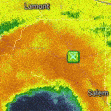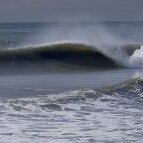All Activity
- Past hour
-
What a beautiful late spring day
-
Records: Highs: EWR: 89 (2013) NYC: 88 (1941) LGA: 86 (2013) JFK: 84 (1967) Lows: EWR: 33 (1945) NYC: 37 (1888) LGA: 38 (1945) JFK 39 (1996) Historical: 1679: New England from the 4th to the 5th: The Great Northeastern Rainstorm and Flood of October 1869 dumps 7.15 inches of rain in 24 hours on Middletown, Connecticut, most coming the morning of the 4th. Northeastern coastal Maine takes the full brunt of the hurricane as the storm surge produces tremendous tides. At the entrance to the Bay of Fundy, the islands of Deer, Grand Manan, and Campobello all sustain severe damage from wind and tide, as did the communities of Eastport and Calais, Maine . (Ref. WxDoctor) 1777 - The Battle of Germantown was fought in a morning fog that grew more dense with the smoke of battle, causing great confusion. Americans firing at each other contributed to the loss of the battle. (David Ludlum) 1867: Galveston, TX has a track record of severe hurricanes. Almost 30 years to the day after the famous Racer's Hurricane struck the island city; another major hurricane brought violent winds and inundation. All of the wharves in Galveston were reportedly destroyed. (Ref. Wilson Wx. History) 1869 - A great storm struck New England. The storm reportedly was predicted twelve months in advance by a British officer named Saxby. Heavy rains and high floods plagued all of New England, with strong winds and high tides over New Hampshire and Maine. Canton CT was deluged with 12.35 inches of rain. (David Ludlum) 1877: Washington, DC set a new 24-hour rainfall record for the month of October when 3.98" fell on the 4th. (Ref. Rainfall record as of the year 1877) 1957: The world's first artificial satellite, Sputnik, was launched on October 4th, 1857 by the Soviet Union. Sputnik was about the size of a beach ball and weighed 183.9 pounds. It took about 98 minutes to orbit Earth on an elliptical path. 1963: Hurricane Flora spent 11 days wreaking havoc along her path through the Caribbean. The storm brought 170 mph winds and an 11 foot storm surge to Haiti, killing 5,000 people, making it the island nation's most destructive hurricane. The slow moving storm brought 15 - 20 inches of rain in 72 hours to parts of Cuba. The floods and mudslides killed 1,300 people in that island nation. Castro refused the United States' offer of help. (Ref. Wilson Wx. History) 1969 - Denver, CO, received 9.6 inches of snow. October of that year proved to be the coldest and snowiest of record for Denver, with a total snowfall for the month of 31.2 inches. (Weather Channel) 1974: Killing frost on 3rd and 4th in suburbs National Airport had a low of 34°F on the 4th. (Washington Weather Records - KDCA) (Ref. Many Additional Temperatures Listed On This Link) 1986 - Excessive flooding was reported along the Mississippi River and all over the Midwest, from Ohio to the Milk River in Montana. In some places it was the worst flooding of record. (Sandra and TI Richard Sanders - 1987) 1987 - A storm brought record snows to the northeastern U.S. Snowfall totals ranged up to 21 inches at North Springfield VT. It was the earliest snow of record for some locations. The storm claimed 17 lives in central New York State, injured 332 persons, and in Vermont caused seventeen million dollars damage. The six inch snow at Albany NY was their earliest measurable snow in 117 years of records. (The National Weather Summary) (Storm Data) (The Weather Channel) 1987 - Southern California continued to "shake and bake". An earthquake was reported during the morning, the second in a matter of days, and during the afternoon temperatures soared well above 100 degrees. Highs of 100 degrees at San Francisco, and 108 degrees at Los Angeles and Santa Maria, were October records. San Luis Obispo was the hot spot in the nation with an afternoon high of 111 degrees. (The National Weather Summary). 1987: A storm brought record snows to the northeastern U.S. Snowfall totals ranged up to 21 inches at North Springfield, VT. It was the earliest snow of record for some locations. The storm claimed 17 lives in central New York State, injured 332 persons, and in Vermont caused seventeen million dollars damage. The six-inch snow at Albany, NY, was their earliest measurable snow in 117 years of records. 1988 - Temperatures dipped below freezing in the north central U.S. Five cities in North Dakota and Nebraska reported record low temperatures for the date, including Bismarck ND with a reading of 17 degrees above zero. Low pressure brought snow and sleet to parts of Upper Michigan. (The National Weather Summary) 1989 - Unseasonably cold weather continued in the north central U.S., with freezing temperatures reported across much of the area from eastern North Dakota to Michigan and northwest Ohio. Thirteen cities reported record low temperatures for the date, including Saint Cloud MN, which was the cold spot in the nation with a morning low of 19 degrees. (The National Weather Summary) 1995: Opal became a hurricane on October 2. Opal continued to strengthen, and a period of rapid strengthening late of the 3rd and early on the 4th made it a Category 4 hurricane. Opal weaken on the 4th, and Opal was a Category 3 hurricane when it made landfall near Pensacola Beach, Florida late on the 4th. Opal continued quickly north-northeastward and became extratropical over the Ohio Valley on the 5th. Hurlbert Field, Florida reported sustained winds of 84 mph with a peak gust of 144 mph, and gusts to 70 mph occurred as far inland as northwest Georgia. However, the main impact from Opal was from storm surge. A combination of storm surge and breaking waves inundated portions of the western Florida Panhandle coast to a depth of 10 to 20 ft. The surge was responsible for the bulk of the $3 billion in damage attributed to Opal in the United States. Opal was responsible for 9 deaths in the United States, including 8 from falling trees and one from a tornado. Opal was responsible for 50 deaths in Mexico and Guatemala due to flooding caused by heavy rains.(Ref. Additional Information At This Link) (Ref. AccWeather Weather History) 1998: Two rounds of thunderstorms at Kansas City, MO produced flash floods that killed 12 people. Most people died after driving their automobiles into rushing water. Over 100 water rescues were required during the event. 7 people died when their cars became stranded on a single bridge over Brush Creek. The National Weather Service received a commendation for their excellent warnings during the event. The first of numerous flash flood warnings had a lead time of over 30 minutes. Total damage exceeded $50 million dollars. (Ref. Wilson Wx. History) Oklahoma: 27 tornadoes touch down across Oklahoma establishing the national record for tornadoes in any state on a single October day. (Ref. WxDoctor) On the backside of this storm, an early season blizzard struck much of Converse and Niobrara Counties in Wyoming. 8 to 12 inches of heavy, wet snow fell from late on the 4th into the 5th over many areas. This combined with 40 mph winds snapped about 200 power poles and left about 4,000 people without power in Lusk and Manville for up to 5 days.(Ref. Wilson Wx. History) (Ref. AccWeather Weather History) 2005: Hurricane Stan made landfall along the Mexican coastline southeast of Veracruz. Torrential rains of 10 to 15 inches caused extensive flooding and loss of life across Central America. Death tolls reached 23 in Mexico, Nicaragua and Honduras, and 62 in El Salvador, but the greatest loss of life came in Guatemala, where as many as 2,000 people were killed in rain-related flooding and landslides. (Ref. Wilson Wx. History) Calendar day lows across much of the Midwest were 20 to 30 degrees warmer than normal. October 4th record-high minimum temperatures: 74 degrees (Lincoln, NE); 73 (Omaha, NE); 72 (Moline, IL); 71 (Rochester, MN and Waterloo, IA) ; 70 (Green Bay, WI). (Ref. Weather Guide Calendar with Phenomenal Weather Events 2011 Accord Pub. 2010, USA) 2006: Shoshone, Idaho: A rare October tornado touches down near Shoshone, Idaho community but causes no significant damage. NWS reports this is only the second recorded October tornado in the state. The previous occurred in October 1984 in Ada County.(Ref. WxDoctor) 2013: While western South Dakota was dealing with a crippling blizzard, the tri-state region of Nebraska, South Dakota, and Iowa saw several tornadoes, including an EF-4. This violent tornado started 2 miles southwest of Climbing Hill, Iowa, flattening corn crops and snapping tree trunks. As the tornado moved northeast, it intensified and struck a farmstead approximately 5 miles west-northwest of Correctionville, Iowa. Sheds and other buildings were severely damaged or destroyed, with the residence being severely damaged. The tornado continued to increase in both size and magnitude as it continued on its trek northeast. The tornado reached its maximum intensity 2.5 miles south of Pierson, Iowa, when this mile-wide tornado struck two farmsteads. Numerous outbuildings and barns were destroyed, with farm equipment being tossed over 400 yards. It was here that the tornado was rated EF-4. The tornado stayed southeast of Pierson, Iowa, and to the west of Washta, Iowa. Before lifting, the tornado produced more tree damage and downed power poles and lines 2 miles west of Washta, Iowa.
-
64 / 54 and off to the races. 96 hours of late summer with low - mid 80s, perhaps a few 86/87 in the warmest spots. Front by Tue night an Wed AM mat bring some rain in the 0.25 - 0.50 range. Cooler / near normal Wed - Fri before warming by the end of the week and next weekend. Overall near normal / slightly warmer till mid month. 10/4 - 10/7 : Much warmer 10/8 - 10/10 : Cooler near normal (Front brings rain 10/7 AM - 10/8) 10/11 - 10/15 : Near - above normal 10/ 16 - Cooler
-
50 here this morning
-

Spooky Season (October Disco Thread)
tamarack replied to Prismshine Productions's topic in New England
Not here - it's our wettest month and Oct 2005 (14.09") is the most for any month. Our first full month here, June 1998, is 2nd with 12.81". Third place is shown below. J 3.23" J 3.96" F 2.95" A 4.10" M 3.71" S 3.70" (Despite 11.46" in 1999.) A 4.09" O 5.45" M 3.96" N 4.22" J 4.76" D 4.87" TOTAL: 49.27" -
75/38 yesterday 42 this morning...Will tack on 40 later
-
Yesterday, Toledo had a high of 86, low of 48. 86 is close to the record of 90, and 48 is one degree below normal.
-
Reminds me of the Octobers growing up.
-
Tropical Storm Matmo has emerged from Luzon, Philippines recently and will be headed toward Hainan Island with strength of 85kt
-
49 this morning, up to 64
- Today
-
t 55.2 DP 43.6 in NE Monmouth Co. But snowing in Red Lodge Montana.... https://www.redlodgemountain.com/webcam/
-
41 this morning.
-
3 straight mornings in the 40s, which shouldn’t be very remarkable for October.
-
What are you talking about? Did you think I meant that 85/65 didn't feel too bad from inside a home? LOL
-
The -IOD is enhacing it
-
2025-2026 ENSO
PhiEaglesfan712 replied to 40/70 Benchmark's topic in Weather Forecasting and Discussion
Of course, those mid-90s seasons (especially 92-93 and 93-94) were aided by the temporary cool down in climate due to Pinatubo in 1991. -

Spooky Season (October Disco Thread)
kdxken replied to Prismshine Productions's topic in New England
We rain. -
90°+ would be the warmer days during the summer. But past summers would have many days remaining in the 80s even during July. 2009 was our last cooler summer before the summers dramatically warmed since 2010. Only 1 day made it to 90° at the warm spots like Newark. Climatological Data for NEWARK LIBERTY INTL AP, NJ - July 2009 Click column heading to sort ascending, click again to sort descending. Sum 2577 2028 - - 0 293 6.60 T - Average 83.1 65.4 74.3 -3.9 - - - - 0.0 Normal 86.9 69.4 78.2 - 0 408 4.66 0.0 2009-07-01 81 66 73.5 -3.5 0 9 0.00 0.0 0 2009-07-02 79 68 73.5 -3.7 0 9 0.23 T 0 2009-07-03 81 65 73.0 -4.4 0 8 0.08 0.0 0 2009-07-04 83 65 74.0 -3.5 0 9 0.00 0.0 0 2009-07-05 81 63 72.0 -5.7 0 7 0.00 0.0 0 2009-07-06 86 60 73.0 -4.8 0 8 0.00 0.0 0 2009-07-07 82 64 73.0 -4.9 0 8 0.11 0.0 0 2009-07-08 80 59 69.5 -8.6 0 5 0.00 0.0 0 2009-07-09 74 62 68.0 -10.2 0 3 0.00 0.0 0 2009-07-10 77 58 67.5 -10.7 0 3 0.00 0.0 0 2009-07-11 79 62 70.5 -7.8 0 6 0.24 0.0 0 2009-07-12 84 64 74.0 -4.4 0 9 0.03 0.0 0 2009-07-13 83 61 72.0 -6.4 0 7 0.00 0.0 0 2009-07-14 83 60 71.5 -7.0 0 7 0.00 0.0 0 2009-07-15 87 62 74.5 -4.0 0 10 0.00 0.0 0 2009-07-16 91 71 81.0 2.5 0 16 0.00 0.0 0 2009-07-17 88 69 78.5 0.0 0 14 0.07 0.0 0 2009-07-18 86 70 78.0 -0.5 0 13 T 0.0 0 2009-07-19 85 63 74.0 -4.5 0 9 0.00 0.0 0 2009-07-20 83 67 75.0 -3.5 0 10 0.00 0.0 0 2009-07-21 73 65 69.0 -9.5 0 4 0.78 0.0 0 2009-07-22 82 65 73.5 -5.0 0 9 0.00 0.0 0 2009-07-23 79 65 72.0 -6.4 0 7 0.14 0.0 0 2009-07-24 83 65 74.0 -4.4 0 9 0.00 0.0 0 2009-07-25 84 64 74.0 -4.3 0 9 0.07 0.0 0 2009-07-26 87 69 78.0 -0.3 0 13 1.03 T 0 2009-07-27 86 69 77.5 -0.7 0 13 0.18 0.0 0 2009-07-28 87 72 79.5 1.3 0 15 T 0.0 0 2009-07-29 85 73 79.0 0.9 0 14 2.97 T 0 2009-07-30 89 73 81.0 2.9 0 16 0.00 0.0 0 2009-07-31 89 69 79.0 1.0 0 14 0.67 0.0 0
-
NWS now calling for 1" or more of rain Tuesday - Wednesday here. Nice!
-
Yeah, the much warmer temperatures at places like Boston separates this record low 7 year run from previous well below average streaks. The 7 year period ending in 1992 was several degrees colder. So much of that periods lower snowfall was related to issues other than temperatures being too warm. This is why it’s unlikely that Boston will see 3 seasons before this decade is out with 83” to 107” snow. Since this much warmer climate would struggle to produce such high totals in quick succession like 1992-1993 to 1995-1996 did. This is why it will be more challenging for Boston and other l-95 cities to the south to end this current much lower snowfall period like they did back in the early to mid-90s without a major VEI 7 or larger volcanic eruption to cool the climate down temporarily. Boston average snowfall 2019-2025….26.6”……DJF average temperature….34.6° Boston average snowfall 1986-1992….29.9”……DJF average temperature….32.2° Outstanding seasons following that lower snowfall period which ended the 7 year low 1992-1993…..83.9”……31.4° 1993-1994…..96.3”……27.8° 1995-1996…..107.6”……30.9°
-
Do you have a reference for this? Per the articles below, we have had larger crops due to technology improvement not climate change. The impact of climate change depends on the crop and region. No large net impacts so far. On a global average, doesn't look like a disaster in the future either; but, some regions and crops may have significant negative impacts. Also need to consider extreme events which will pack a bigger punch in a warmer world. A bad year can be destabilizing regionally. https://ourworldindata.org/crop-yields-climate-impact https://ourworldindata.org/will-climate-change-affect-crop-yields-future
-
Spooky Season (October Disco Thread)
Snowcrazed71 replied to Prismshine Productions's topic in New England
ICON..... More like I'CANT! -

Spooky Season (October Disco Thread)
ineedsnow replied to Prismshine Productions's topic in New England
0z ICON goes from drought to floods -
You're thinking of the October 2011 event. Highly elevation dependent snow event for a good chunk of the Northeast and Mid Atlantic. The rest of the winter was total garbage as you said.
-

2025 Atlantic Hurricane Season
WxWatcher007 replied to BarryStantonGBP's topic in Tropical Headquarters
I’m cool with that. Op would just need to change the title.











